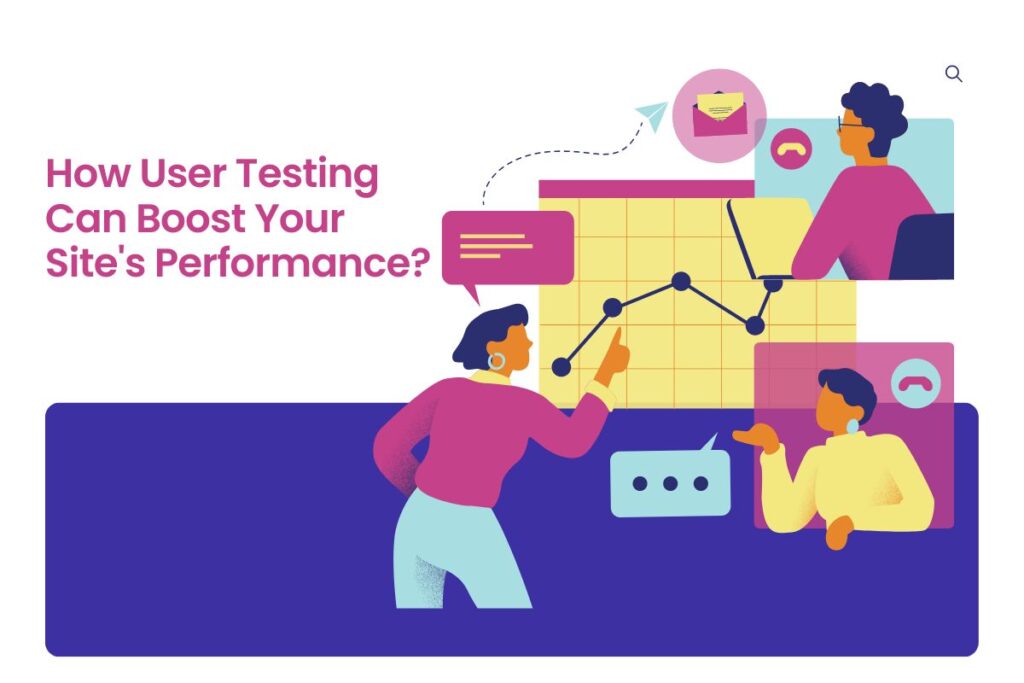A potential customer’s initial impression of your brand is frequently formed by its website. A high-performing website increases engagement, leads to more conversions, and eventually generates income in addition to providing a flawless user experience (UX). How can you, though, make sure your website is operating at peak efficiency? Your best tool is user testing.
What is User Testing, and Why is it Important?

Catching actual users engage with your website and getting their input is known as user testing. It’s an important phase that allows you to grasp the demands and pain points of your target audience by going beyond preconceptions. You can find areas for improvement in terms of usability, navigation, content clarity, and overall site performance by watching how users behave.
Performance Gains with User Testing
Here’s how user testing can specifically help you improve your website’s performance:

Identifying Usability Issues: Users might struggle with confusing navigation, unclear calls to action (CTAs), or overwhelming layouts. User testing reveals these roadblocks, allowing you to streamline navigation, simplify CTAs, and create a more intuitive user journey.
Optimizing Content for User Intent: Effective content caters to what users are looking for. User testing helps you gauge if your content resonates with your audience and addresses their search queries. Based on feedback, you can refine content to improve clarity, prioritize key information, and ensure it aligns with user intent.
Boosting Conversion Rates: A well-designed website guides users towards desired actions, like making a purchase or subscribing to a newsletter. User testing helps you identify conversion bottlenecks. For instance, users might abandon lengthy checkout processes or struggle to find the “Buy Now” button. By addressing these issues, you can streamline the conversion funnel and increase conversion rates.
Enhancing Engagement: A user who gets lost or frustrated on your website is unlikely to stick around. User testing reveals elements that hinder engagement, such as slow loading times, irrelevant content, or intrusive pop-ups. Addressing these issues creates a more engaging experience that keeps users coming back for more.
Prioritizing Development Efforts: Limited resources often mean focusing on areas with the biggest impact. User testing helps you identify the most pressing website issues and prioritize development efforts accordingly. It ensures you’re addressing the pain points that matter most to your users.
Start with User Testing
There are several ways to conduct user testing, from simple in-house sessions to employing specialized testing platforms. Here’s a basic roadmap to get you started:

Define Your Goals: What do you hope to achieve through user testing? Are you focusing on navigation, content effectiveness, or conversion optimization? Clearly defined goals will guide your testing process and ensure you collect the most relevant data.
Recruit Test Users: Determine who the people in your target audience are. Seek a group that is diverse in terms of online activity, technological proficiency, and demographics. Utilizing resources such as Lookback.io and UserTesting.com, you can find participants remotely.
Develop User Scenarios: Create realistic tasks that users might perform on your website. This could be searching for a specific product, completing a purchase, or signing up for a service.
Conduct the Test: As you lead people through the scenarios, keep track of their thoughts and frustrations and see how they behave. Tell them to “think aloud” as they browse the internet.
Analyze the Results: After testing is over, examine the data to find trends and feedback from customers. Look for trends in the way users behave and the places where they had the greatest difficulty.
Prioritize and Implement Changes: Give the website updates with the greatest possible impact the highest priority based on your findings. Create a strategy to put the changes into action, then make adjustments in response to more customer feedback.
Effective User Testing Tips
Focus on Quality, Not Quantity: A well-selected group of users can offer insightful information. Focused input from pertinent consumers is preferable to a big collection of general data.
Maintain Objectivity: Don’t be defensive when users encounter problems. Focus on understanding the issues and finding solutions.
Think Beyond Words: Even if user reviews are insightful, pay attention to their facial expressions and body language as well. Nonverbal clues frequently indicate repressed emotions.
Iterate and Test Again: Optimizing a website is a continuous effort. Conduct follow-up testing to evaluate the modifications’ efficacy and pinpoint additional areas that require improvement once they have been implemented.
Final Words
User testing is an effective technique that can help your website function much better. You may design a website that is not only user-friendly but also produces better business results by paying attention to actual users and comprehending their requirements. Thus, don’t be scared to go right into user testing and see your website’s potential.



